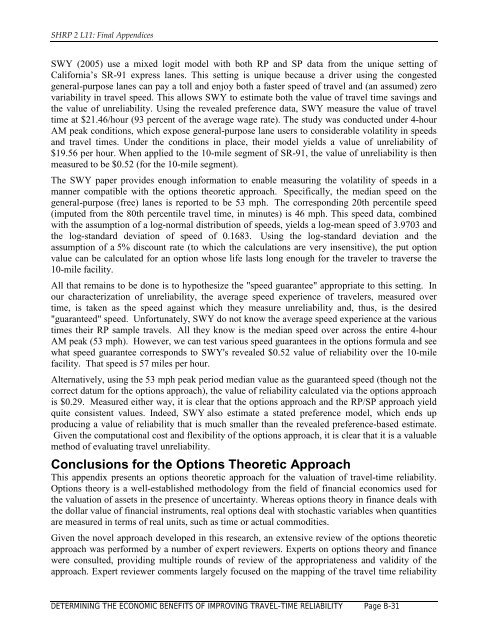Evaluating Alternative Operations Strategies to Improve Travel Time ...
Evaluating Alternative Operations Strategies to Improve Travel Time ...
Evaluating Alternative Operations Strategies to Improve Travel Time ...
Create successful ePaper yourself
Turn your PDF publications into a flip-book with our unique Google optimized e-Paper software.
SHRP 2 L11: Final Appendices<br />
SWY (2005) use a mixed logit model with both RP and SP data from the unique setting of<br />
California’s SR-91 express lanes. This setting is unique because a driver using the congested<br />
general-purpose lanes can pay a <strong>to</strong>ll and enjoy both a faster speed of travel and (an assumed) zero<br />
variability in travel speed. This allows SWY <strong>to</strong> estimate both the value of travel time savings and<br />
the value of unreliability. Using the revealed preference data, SWY measure the value of travel<br />
time at $21.46/hour (93 percent of the average wage rate). The study was conducted under 4-hour<br />
AM peak conditions, which expose general-purpose lane users <strong>to</strong> considerable volatility in speeds<br />
and travel times. Under the conditions in place, their model yields a value of unreliability of<br />
$19.56 per hour. When applied <strong>to</strong> the 10-mile segment of SR-91, the value of unreliability is then<br />
measured <strong>to</strong> be $0.52 (for the 10-mile segment).<br />
The SWY paper provides enough information <strong>to</strong> enable measuring the volatility of speeds in a<br />
manner compatible with the options theoretic approach. Specifically, the median speed on the<br />
general-purpose (free) lanes is reported <strong>to</strong> be 53 mph. The corresponding 20th percentile speed<br />
(imputed from the 80th percentile travel time, in minutes) is 46 mph. This speed data, combined<br />
with the assumption of a log-normal distribution of speeds, yields a log-mean speed of 3.9703 and<br />
the log-standard deviation of speed of 0.1683. Using the log-standard deviation and the<br />
assumption of a 5% discount rate (<strong>to</strong> which the calculations are very insensitive), the put option<br />
value can be calculated for an option whose life lasts long enough for the traveler <strong>to</strong> traverse the<br />
10-mile facility.<br />
All that remains <strong>to</strong> be done is <strong>to</strong> hypothesize the "speed guarantee" appropriate <strong>to</strong> this setting. In<br />
our characterization of unreliability, the average speed experience of travelers, measured over<br />
time, is taken as the speed against which they measure unreliability and, thus, is the desired<br />
"guaranteed" speed. Unfortunately, SWY do not know the average speed experience at the various<br />
times their RP sample travels. All they know is the median speed over across the entire 4-hour<br />
AM peak (53 mph). However, we can test various speed guarantees in the options formula and see<br />
what speed guarantee corresponds <strong>to</strong> SWY's revealed $0.52 value of reliability over the 10-mile<br />
facility. That speed is 57 miles per hour.<br />
<strong>Alternative</strong>ly, using the 53 mph peak period median value as the guaranteed speed (though not the<br />
correct datum for the options approach), the value of reliability calculated via the options approach<br />
is $0.29. Measured either way, it is clear that the options approach and the RP/SP approach yield<br />
quite consistent values. Indeed, SWY also estimate a stated preference model, which ends up<br />
producing a value of reliability that is much smaller than the revealed preference-based estimate.<br />
Given the computational cost and flexibility of the options approach, it is clear that it is a valuable<br />
method of evaluating travel unreliability.<br />
Conclusions for the Options Theoretic Approach<br />
This appendix presents an options theoretic approach for the valuation of travel-time reliability.<br />
Options theory is a well-established methodology from the field of financial economics used for<br />
the valuation of assets in the presence of uncertainty. Whereas options theory in finance deals with<br />
the dollar value of financial instruments, real options deal with s<strong>to</strong>chastic variables when quantities<br />
are measured in terms of real units, such as time or actual commodities.<br />
Given the novel approach developed in this research, an extensive review of the options theoretic<br />
approach was performed by a number of expert reviewers. Experts on options theory and finance<br />
were consulted, providing multiple rounds of review of the appropriateness and validity of the<br />
approach. Expert reviewer comments largely focused on the mapping of the travel time reliability<br />
DETERMINING THE ECONOMIC BENEFITS OF IMPROVING TRAVEL-TIME RELIABILITY Page B-31















